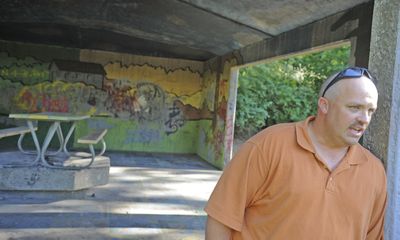Graffiti is constant battle for police, parks department, volunteers

Earlier this summer, a picnic shelter in the lower part of Lincoln Park was tagged with red and blue graffiti.
Like several times before, the graffiti outside the shelter was removed by staff from the Spokane parks department, yet a lot of graffiti remains on the inside of the shelter. Also on the inside walls of the picnic shelter is a mural done by neighbors and children from Franklin Elementary School six or seven years ago.
“You obviously can’t remove the graffiti without removing the mural at the same time,” said Eric Walker, an officer with the Spokane Police Department who works on graffiti prevention. “I mean, the parks department paints over the really bad words, but the mural itself should be maintained.”
Many murals in Spokane – under freeway overpasses and railroad bridges – actually are being maintained, but it’s done by volunteers and with a shoestring budget.
“The Arts Commission does a couple of full days of work on the mural repairs every year,” said Karen Mobley, arts director for the city of Spokane. “I usually round up some volunteers, fill my van with every conceivable color and start on one end of town and work on covering and matching the colors along the way.”
Mobley said this year volunteers have spent 70 hours on mural maintenance between the Sunset Highway and Havana, using donated or very cheaply purchased paint and supplies.
“I have also had a couple of artists go out to work on specific murals that need to be fixed,” said Mobley.
Walker admits that his crusade against graffiti has become personal.
He said he is frustrated that the Parks and Recreation Department doesn’t clean up graffiti as fast as property owners have to do it.
“The rules should be the same for them as for a property owner: The graffiti should be removed within 10 days,” Walker said. He also expressed frustration over graffiti at the skate park under the freeway downtown.
Taylor K. Bressler, the Parks and Recreation Department planning and development manager, said he is tired of people pointing fingers at the skate park.
“We end up being the focal point on graffiti because of the skate park, and because there are groups that would like for us to close it down,” Bressler said. “I feel bad for the skateboarders that are caught in between this. We don’t have the same graffiti problem at the skate park in Hillyard.”
Bressler said it’s the entire area beneath Interstate 90 that is problematic, not just the skate park.
“Far less attention is paid to the area under the freeway today than in years past,” Bressler said. “When I send my staff down there to clean up, they tell me that the bushes are full of homeless people and other people doing bad stuff.”
Walker would like to see the graffiti removed from the skate park because what he calls “free expression areas” don’t cut down on graffiti anywhere else.
“Research has shown that the faster you clean up graffiti, the less likely you are to get tagged again,” said Walker. He adds that there’s no tie between skateboarding and graffiti; taggers and graffiti painters just feel safe to paint away at the skate park.
Bressler said graffiti is a huge problem for the parks department, and he doesn’t know how much money and time staff is spending on cleaning it up.
“We try the best we can, we just don’t have manpower or attentiveness to always do it right away,” Bressler said. “You have to work together to find a solution. You can’t just say that it should be removed. The issue is much bigger than that.”
Walker said most property owners do a good job of cleaning up graffiti in a timely manner, but neighborhoods with a high concentration of rentals and absentee landlords tend to be hit heavily.
“It’s gotten to a point where people don’t even really see graffiti anymore. Now that’s sad,” said Walker. “Graffiti is not OK. It’s against the law. If we give up and stop removing it, then the vandals will win.”